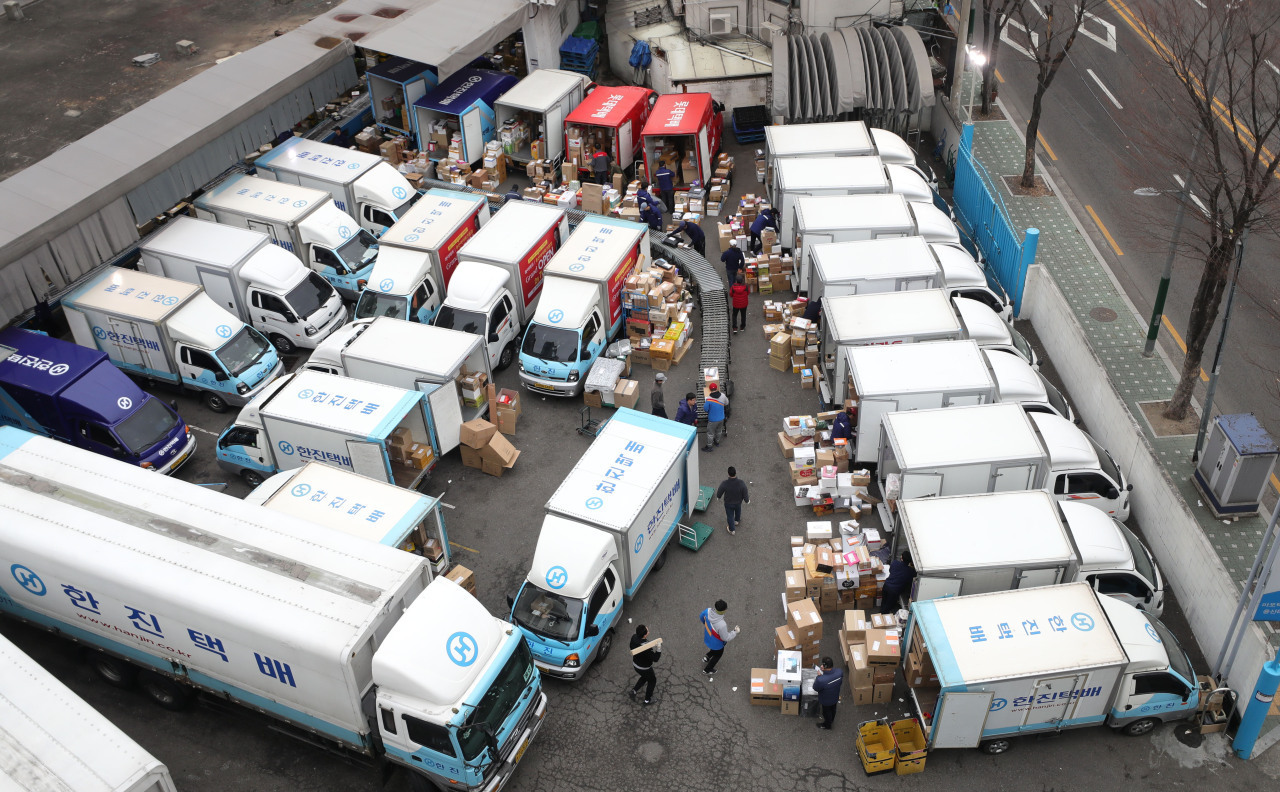Demand for courier service soared during pandemic: study
Pandemic saw surge in demand for courier services, particularly among those in 20s and 70s
By Yim Hyun-suPublished : July 4, 2021 - 15:27

As the coronavirus pandemic swept across Korea, courier services enjoyed a surge in popularity, a new study has revealed.
The average number of times people used a courier service rose from 6.22 per month to 9.74 after the pandemic began, according to the recent study, the Korea Transport Institute said Sunday.
The study was conducted by researchers at the institute with a sample of 1,153 respondents during November last year to highlight the differences in how people use delivery services in Korea after the coronavirus began to spread.
The parcel delivery service industry, also known as “taekbae” in Korea, has been the “physical movement behind online consumption activities,” the study said, but issues such as a “lack of supply of logistics facilities” and “worsening labor conditions” are challenges the industry will need to tackle in the future.
At the current growth rate, Korea’s parcel volume is set to reach 5.6 billion boxes in the second half of 2023, double the figure of 2019 -- two years earlier than the previous estimate.
When broken down by age, those in their 20s used delivery services 9.5 times a month compared to 5.36 times pre-pandemic, up some 77 percent and marking the biggest jump among all age groups.
Those in their 70s came second, with their frequency of delivery service use increasing from 5.03 per month to 8.19 – about a 63 percent jump.
“The result seems to reflect the fact that more universities began to offer online classes while older people who are at higher risk tend to avoid danger,” the study said.
While those whose monthly income is between 3 million and 4 million won ($2,650-$3,500) previously used delivery services slightly more than other groups before the pandemic began, the study showed that people with higher incomes in general tended to use delivery services more often.
When broken down by items, food saw the biggest jump in deliveries, up nearly 84 percent from pre-pandemic, followed by books, home appliances and household goods.
With people spending more time at home to avoid contact with others, there were fewer outdoor activities while demand for daily necessities and cultural life increased, the study explained.
The average number of times people used a courier service rose from 6.22 per month to 9.74 after the pandemic began, according to the recent study, the Korea Transport Institute said Sunday.
The study was conducted by researchers at the institute with a sample of 1,153 respondents during November last year to highlight the differences in how people use delivery services in Korea after the coronavirus began to spread.
The parcel delivery service industry, also known as “taekbae” in Korea, has been the “physical movement behind online consumption activities,” the study said, but issues such as a “lack of supply of logistics facilities” and “worsening labor conditions” are challenges the industry will need to tackle in the future.
At the current growth rate, Korea’s parcel volume is set to reach 5.6 billion boxes in the second half of 2023, double the figure of 2019 -- two years earlier than the previous estimate.
When broken down by age, those in their 20s used delivery services 9.5 times a month compared to 5.36 times pre-pandemic, up some 77 percent and marking the biggest jump among all age groups.
Those in their 70s came second, with their frequency of delivery service use increasing from 5.03 per month to 8.19 – about a 63 percent jump.
“The result seems to reflect the fact that more universities began to offer online classes while older people who are at higher risk tend to avoid danger,” the study said.
While those whose monthly income is between 3 million and 4 million won ($2,650-$3,500) previously used delivery services slightly more than other groups before the pandemic began, the study showed that people with higher incomes in general tended to use delivery services more often.
When broken down by items, food saw the biggest jump in deliveries, up nearly 84 percent from pre-pandemic, followed by books, home appliances and household goods.
With people spending more time at home to avoid contact with others, there were fewer outdoor activities while demand for daily necessities and cultural life increased, the study explained.


















![[Today’s K-pop] Treasure to publish magazine for debut anniversary](http://res.heraldm.com/phpwas/restmb_idxmake.php?idx=642&simg=/content/image/2024/07/26/20240726050551_0.jpg&u=)